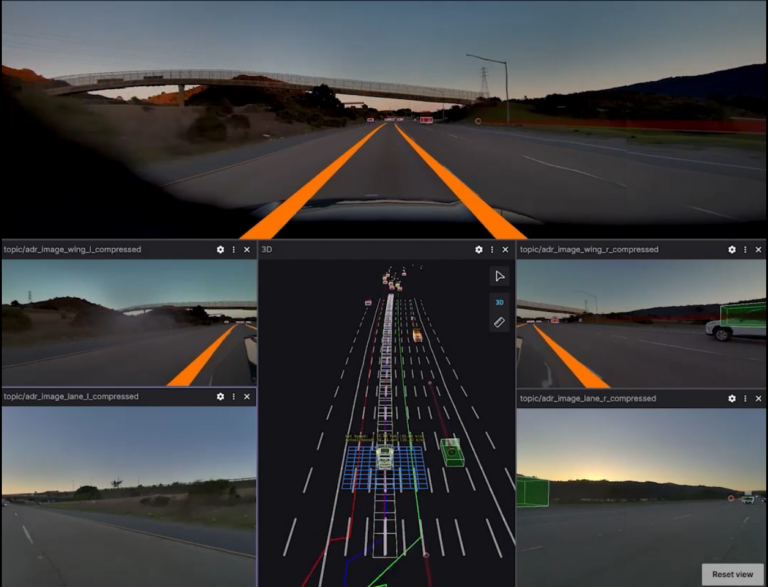Rivian has taken a significant step into the world of autonomous driving technology with the release of its Enhanced Highway Assist (EHA) feature. This hands-free highway driving capability is a defining moment in the electric vehicle manufacturer’s journey toward advanced driver assistance systems.
The Technology Behind Rivian’s Hands-Free Driving
Rivian’s Enhanced Highway Assist isn’t merely another driver assistance feature—it represents years of in-house development and a comprehensive approach to vehicle autonomy. The system allows drivers to remove their hands from the steering wheel on compatible highways while the vehicle manages steering, acceleration, and braking functions.
At the core of this technology is the Rivian Autonomy Platform, built on three essential components:
Advanced Sensor Suite
The system utilizes an impressive array of 11 cameras and 5 radars that create a full 360-degree view around the vehicle. According to Rivian, their in-house developed cameras offer “the highest resolution of any vehicle in North America,” while the strategic placement of overlapping radars provides enhanced visibility in challenging conditions such as fog, darkness, and glare.
Powerful Onboard Computing
Rivian’s vehicles contain a central compute module capable of processing over 200 trillion operations per second—making them incredibly powerful mobile computers. This processing capability is essential for the real-time decision-making required for autonomous driving features.
Sophisticated Machine Learning Models
The system employs Rivian-trained machine learning algorithms based on transformer architectures, enabling the vehicle to understand and interpret its surroundings. Unlike many competitors that use “late sensor fusion” (processing data from individual sensors separately), Rivian implements “early sensor fusion,” combining raw information from all sensors into a unified world model for greater accuracy and reliability.
Current Capabilities and Future Expansion
At launch, Enhanced Highway Assist operates on approximately 135,000 miles of highways across the United States and Canada. While this represents a substantial network, Rivian has already announced plans for “significant expansion” in 2026, including extending the capability to “off-highway roads.”
The current system is classified as a hands-off, eyes-on feature, meaning drivers must maintain visual attention on the road even when their hands are free from the steering wheel. An infrared camera embedded in the rearview mirror monitors driver attentiveness, issuing warnings if attention drifts and eventually disengaging if the driver’s gaze leaves the road for too long.
Looking ahead, Rivian has outlined an ambitious roadmap for its autonomous capabilities:
- Later this year: Expansion of hands-off/eyes-on features to more highways and select surface roads
- Next year: Introduction of a hands-off/eyes-off feature for controlled conditions, representing a move toward Level 3 automation
The planned hands-off, eyes-off functionality would allow drivers to divert attention from the road in certain situations, such as low-speed stop-and-go traffic. This type of Level 3 automation remains rare in the automotive industry due to regulatory challenges and liability concerns.
Beyond Autonomous Driving: Additional Performance Updates
Alongside Enhanced Highway Assist, Rivian announced several other software improvements and performance options:
- A new Rally drive mode for dual-motor vehicles, delivering enhanced throttle response and steering precision across various terrains
- An optional performance upgrade (available for a one-time fee of $5,000) that unlocks 665 horsepower and 829 lb-ft of torque, along with three additional drive modes
- Various quality-of-life improvements, including easier wheel size swapping, automatic mirror tilting during parallel parking, and remote charge port control via the mobile app
Rivian’s Philosophy on Autonomous Technology
While many automakers frame autonomous driving features primarily as convenience enhancements, the safety implications cannot be overlooked. Recent studies, including one by the Insurance Institute for Highway Safety, indicate that drivers frequently circumvent the safety rules governing driver-assist systems.
Rivian’s approach appears to balance innovation with responsibility. As the company states: “While being first to market with new capabilities is important, our #1 goal is being the most trusted. As our technology advances, our intention is to do it safely, responsibly, and ultimately make driving less stressful and to give you back your time.”
This stance acknowledges both the transformative potential of autonomous driving technology and the significant challenges that remain in its implementation. As Rivian continues to develop and refine its Autonomy Platform, the company is positioning itself as a serious contender in the evolving landscape of electric vehicles with advanced driver assistance systems.
For Rivian owners, the promise is clear: a driving experience that’s not only environmentally conscious but increasingly intelligent, responsive, and convenient—allowing them to “arrive at [their] destination feeling refreshed.”
If you are interested in this topic, we suggest you check our articles:
- The Role of AI in Self-Driving Cars
- The Mercedes Car Future: Automaker Aims to Transform Driver Interaction with In-Car Conversational AI
- Driving Smarter with Waze Voice Assistance and AI Technology
Written by Alius Noreika


